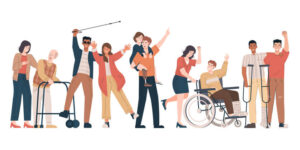
According to the U.S. Census, one out of every five Americans lives with a disability. Until quite recently, many of these persons were at a disadvantage when it came to public and private services and access provided to them, especially as compared to services and access provided to persons without disabilities.
Enter the ADA
Passed into law in 1990, the Americans with Disabilities Act (ADA) is civil rights legislation that prohibits discrimination based on a person’s disability. It extends many of the protections granted in the landmark Civil Rights Act of 1964 (which prohibited discrimination based on race, sex, religion, national origin and other characteristics) to disabled persons. In particular, the ADA imposes accessibility requirements on public institutions, accommodations and businesses that specifically include schools.
Dangers of Not Complying with the ADA
If such an institution, accommodation or business does not comply with the ADA, it can be sued by the government, and a court can order the organization to remedy violations of accessibility regulations and/or mandate that penalties are paid. In some states, such as California, Florida, Hawaii and Illinois, persons with disabilities may be eligible for monetary damage awards and legal fee reimbursements from organizations in violation of the ADA.
How Driving Schools Can Comply
Of course, one category of schools that must follow the law just like any other type of school is driving schools. Driving schools need to consider all of the “touchpoints” where they interact with students — in the classroom, in vehicles and online via websites, email, etc. — and make sure that they are complying with the law so that, ideally, there’s no difference (or extra burden in place) in terms of services provided and customer experience for persons with disabilities as compared to those without.
For each of these touchpoints, driving schools must try to “reasonably accommodate” students that are disabled in any way as defined by the ADA and its amendments. Some of the major disabilities that are protected by provisions of the ADA include: blindness, deafness, intellectual disability, completely or partially missing limbs or mobility impairments that mandate the use of a wheelchair, cancer, autism, cerebral palsy, epilepsy, diabetes, attention deficit hyperactivity disorder (ADHD), multiple sclerosis, muscular dystrophy, Human Immunodeficiency Virus (HIV) infection, major depressive disorder, bipolar disorder, obsessive-compulsive disorder, post-traumatic stress disorder (PTSD) and schizophrenia.
Classroom Compliance
For classrooms, there are five areas to focus on as far as creating accessible learning environments for people with disabilities: physical learning spaces, course materials, communication with students, class environments and out-of-class activities.
In terms of physical learning spaces, the classroom location, layout and furniture should all be evaluated to take into account students with potential mobility, vision, hearing and cognitive disabilities. Chair sizes, desk heights, table heights and aisle widths should be paid attention to, especially when considering students in wheelchairs. Sufficient, distributed and well-directed lighting is also crucial.
In terms of course materials, consider materials that offer captioning and transcription. It’s a requirement for educators to make students aware of accessibility features and options.
When communicating with students, emphasize inclusiveness, and make sure that each individual in a class is being provided what they need to learn. Class environments should encourage active participation and involvement of all students.
Aim for reducing social stigma and marginalization via interactive group activities. Be alert for biases and microaggressions in a classroom setting, and don’t wait to address them. Remember that any activities taking place outside the classroom are just as important in these regards as those taking place inside.
Driving Evaluation Compliance
For hands-on driving evaluations, a driving school may wish to have part-time access to an occupational therapist or certified driving rehabilitation specialist who can administer such evaluations, in addition to assessing driver physical functioning, vision, perception, attention, motor function, and reaction times on an individual basis.
In some cases, a school may wish to have one or more members of their staff get certified by the Association for Driver Rehabilitation Specialists (ADED) for these purposes. It takes 30 hours of instruction every 3 years to acquire and maintain a Certified Driver Rehabilitation Specialist (CDRS) credential. A less onerous credential given by the ADED is the Driver Rehabilitation Specialist (DRS) certification, which can be earned by any professional who plans, develops, coordinates and implements driving services for individuals with disabilities.
And for actual driving, it may help if a school either owns a vehicle or has access to one that has been adapted (see ‘Driving Schools May Recommend Vehicle Adaptations,’ below) to address specific disabilities.
Web and App Compliance
In 2019, the U.S. Supreme Court let stand a ruling that determined that the ADA applied to websites and apps of businesses that must be ADA-compliant. In practical terms, this means that organizations that are subject to ADA compliance must make all reasonable efforts to make their websites and apps usable by disabled persons, with as few restrictions as possible.
In many cases, computer and mobile operating systems and Internet browsers will have features built-in that can aid disabled persons (such as the ability to magnify parts of the screen or direct the cursor using the keyboard instead of the mouse). But there are also specific steps an organization can take during the development of a website or app to make sure that all of these capabilities can be taken advantage of and accessed. Good guidelines for making websites and apps ADA-compliant are here and here, respectively.
Driving Schools May Recommend Vehicle Adaptations
Driving schools may freely recommend to students with disabilities that they make adaptations to their vehicles, which may include (but not be limited to): ramps, lifts, custom seating, hand controls, steering devices (such as spinner knobs or other specially designed handles for steering wheels), special mirrors, foot pedal extensions, extenders for dashboard controls and other adaptive tools. A good overall guide to adapting vehicles (and financing the costs) is here.
Additional Resources
The ADED (see above) has developed a Spectrum of Driver Services and Driver Rehabilitation Program Services document that defines a common language and different program models that are useful for a wide range of driving programs, covering driver rehabilitation programs for those medically at-risk individuals with conditions that may affect driving performance or require adaptive driving aids or vehicle modifications. This document also assists drivers and other stakeholders in understanding the differences in driver services that are available and where they should go for these services.
The document format allows for quick references to each program type, who typically provides such services, the expected knowledge of the provider and what services the respective programs should be offering. Providing this document to disabled students may direct them to additional resources and programs that can assist them.
Legal Consultation Is Recommended
In the end, it may benefit a driving school to have a conversation with a lawyer specializing in ADA compliance to make sure that the school has “covered all its bases” and that there are no major liabilities or gaps that aren’t being addressed. As the old saying goes, it’s better to be safe than sorry, and full ADA compliance is not a matter to treat superficially.

